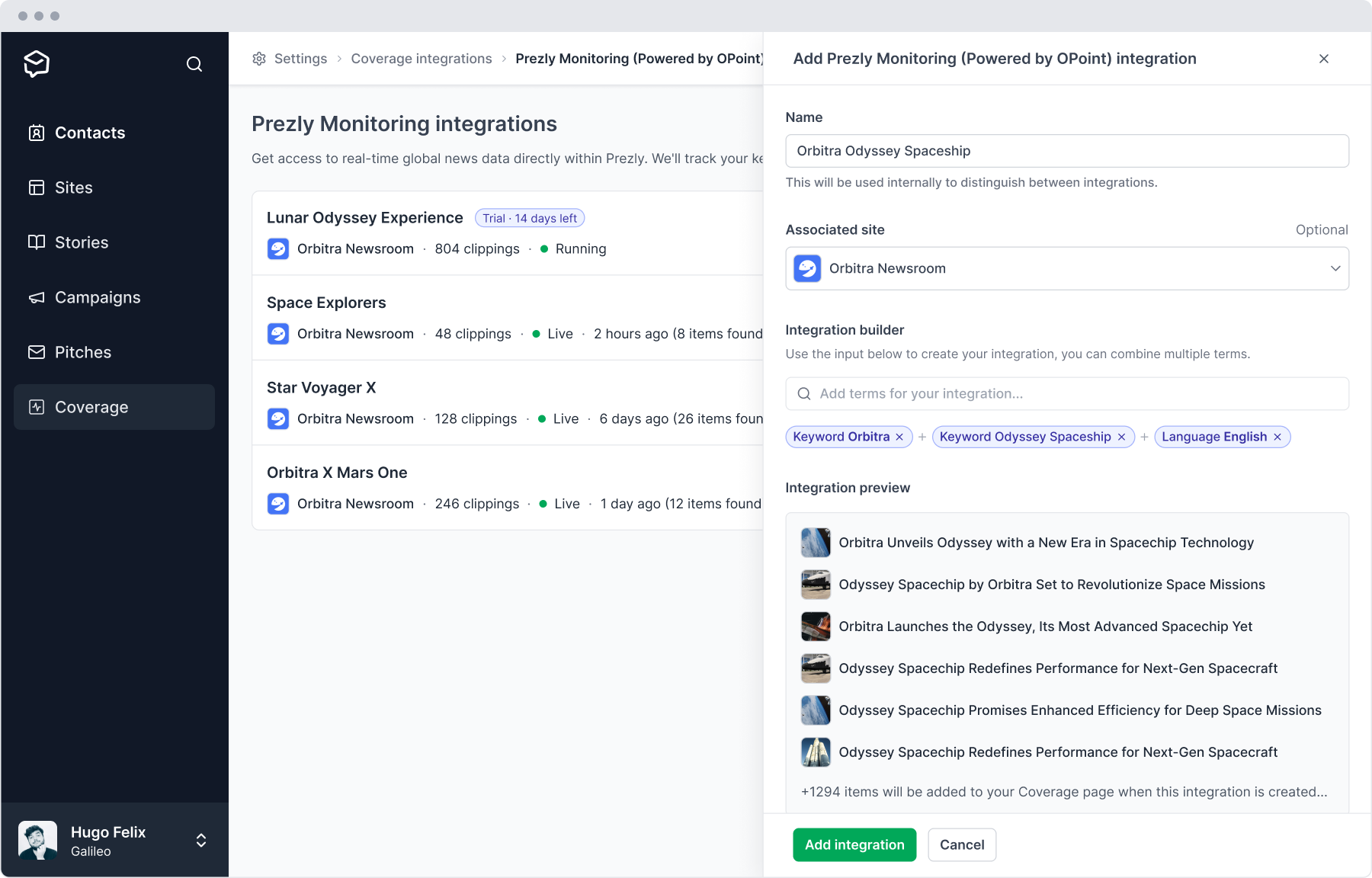How to write a PR report: Examples, templates & more
A guide to planning and executing on your next PR report.
Someone just rushed into your office and demanded a PR report. You've never seen this person. You don't know what a "PR campaign report" is. In the distance, sirens.
If you've been tasked with coming up with a PR report and aren't sure where to start, have no fear. This guide explores everything you need to know about PR reporting, from what it is to practical examples, templates, and tools that make the process easier.
Ready to take the guesswork out of your PR strategy?

A PR report is a document that provides an overview of public relations efforts, results, and their alignment with business goals. It’s a way to measure the impact of PR activities and ensure stakeholders understand the value of the work.
PR reports are usually shared with:
- Clients paying for your services
- Company executives, like CEOs or CFOs
- PR stakeholders
- Department heads and finance teams
Anybody who is invested in your PR efforts should have access to regular reporting on what is being done.
Real coverage at a fraction of the cost
Prezly’s PR CRM, outreach tool, newsroom creator and analytics earn you authentic media coverage by putting journalist relationships first. Starting at $90/month.

Reports in the public relations industry come in various forms, depending on the objectives and the audience. Here are the most common types:
Focuses on a specific PR campaign’s objectives, quantitative metrics, and results, such as earned media or audience reach.
Summarizes ongoing efforts over a month, highlighting media mentions, social metrics, and notable successes.
Analyzes PR activity tied to a specific event, detailing audience engagement, press coverage, and outcomes.
Evaluates the success of PR crisis comms responses, including sentiment analysis and media coverage metrics.
Annual reports are a comprehensive summaries of a year’s PR activities, performance metrics, and their impact on company goals.
The frequency depends on your stakeholders’ needs, so that time period can be monthly, quarterly reports, or throughout and at the end of individual PR campaigns. Regular reporting is a good idea as it lets you adjust your tactics as you go, while less frequent reports are better suited for long-term trend analysis.
Yes. A clippings report is a collection of media mentions and brand coverage, while a PR report connects those mentions to business outcomes and strategy.
Many people will use PR reporting tool or a media monitoring tool to assist with tracking media mentions and reporting on relevant clippings.
Include key metrics like an increase in traffic, social media engagement, media coverage, and increase in sales conversions. Ensure the data reflects your goals.
Explain how the results advance the organization’s objectives, such as increasing brand awareness or driving sales.
Spreadsheets and graphics, while incredibly fun, don't often tell a standalone narrative. As the PR manager or lead in charge, it's your responsibility to explain how that data is getting the company closer to its goals.
Knowing and communicating the data is important to a PR report, but it's crucial to have an actionable plan about what's happening next. How will you learn, grow, and develop from this information in meaningful ways?
Discuss what the data reveals and how you’ll adjust your strategy moving forward. Highlight opportunities for growth and improvement.
Graphs, pie charts, and infographics help convey complex data clearly. You can make these manually in a tool like Google Sheets, or use an AI solution like Jenny to create visualizations of your data.

Follow these steps to create a professional, impactful PR report:
Clarify the objectives of the report, whether it’s for a specific campaign, a monthly update, or a yearly review.
Before you even open a Word document to draft your PR report, ask yourself one: what are the goals of my business/client, and how did I work to achieve those goals?
These goals should have been worked out with your client or external stakeholders when you first sat down to make your PR strategy.
Collect metrics from tools like Prezly, Google Analytics, or social media platforms. Focus on data relevant to your objectives.
Translate raw numbers into actionable insights, and explain how they relate to your goals.
Tell a cohesive PR story about your efforts and their impact, connecting metrics to broader business outcomes.
Outline actionable recommendations based on your findings to guide what the brand should work on next.
Here’s a simple structure for a PR report:
- Introduction: Goals and overview
- Metrics: Key performance indicators
- Analysis: Insights and outcomes
- Next steps: Recommendations and adjustments
Tools like Prezly streamline the process by offering integrated analytics and reporting features, including metrics on how your pitches and press releases perform.
Try Prezly for freeThis streamlined template keeps the focus on measurable outcomes, insights, and clear next steps, avoiding unnecessary fluff while ensuring the report remains results-oriented and actionable.
Campaign overview & objectives
- Summarize the campaign's goals (e.g., increase brand awareness, drive sales, boost media presence) and define the measurable outcomes expected (e.g. "Increase social media mentions by 15%")
- Briefly highlight the key strategies and tactics used to achieve these goals
Coverage summary
- List all media coverage with links to articles, social media posts, or other mentions
- Categorize coverage (e.g., earned media, social media, influencer mentions) and highlight any significant placements
- Include screenshots of notable articles or posts to provide context
Key metrics
- Present the most relevant metrics tied to the campaign goals. For example:
- Website traffic increase (e.g. “15% increase in traffic from media coverage”)
- Social media engagement (e.g. “10,000 new followers across platforms”)
- Media reach (e.g., “50 million impressions across outlets”)
- Any other metrics aligned with the campaign’s goals
Impact of coverage
- For each major media mention, explain how it helped advance the campaign goals. For example:
- "The feature in [Publication] helped increase brand awareness in the tech industry."
- "Social media buzz around the product launch drove a 20% increase in website visits."
Insights & learnings
- Offer actionable insights based on the data, such as:
- "We saw the highest engagement on Instagram, suggesting we should increase influencer collaborations there."
- "Articles in top-tier outlets led to increased web traffic, proving the value of premium media placements."
Next steps
- Provide clear, actionable recommendations for the next phase. For example:
- “Increase media outreach to focus on lifestyle publications.”
- “Develop a new influencer partnership strategy to target younger demographics.”
- Mention any adjustments or changes to the strategy based on the current campaign’s performance
Other work done
- Briefly list other relevant PR activities (e.g., press releases, events, interviews) that contributed to the campaign
A big benefit of using all-in-one PR software like Prezly is that it brings together your pitch data, newsroom analytics, and contact engagement metrics into one place. And because it also supports email campaigns, you can easily share those figures and your logged coverage with your stakeholders, all from a single tool.
Try Prezly for free todayCARMA offers analytics tools for tracking media performance and creating impactful visuals. Not only do they have many great PR analytics tools related to media, and metrics monitoring tools, but they also have tools to display and present the data that has been collected.
CoverageBook simplifies media coverage reporting with an intuitive, copy-paste interface. It lets you turn coverage URLs, like articles or social media posts, into customized reports with screenshots and key metrics. Like all the best PR tools, Coverage Book doesn't try to complicate things, and helps you to create reports that clients can easily understand.
An industry giant, Cision offers tools to monitor media coverage, aggregate key metrics like impressions and share of voice, and analyze the impact of your outreach efforts. With it, you can create customizable reports with visuals, track audience reach and sentiment, and assess how media coverage aligns with business goals.
The downside? It's very, very costly. See our guide to Cision's pricing.

Digital marketing tools like Moz, Ahrefs, Google Alerts, and SEMRush are what you need if search rankings and online visibility factor into your PR strategy. The basics aren't hard to pick up, and some PR tools already incorporate site analytics into their standard offering, so shop around and find a tool that works for you.
Try Prezly for freeHere are just a few of the biggest PR reporting mistakes.
Your metrics should align with the objectives you set at the start.
Clearly demonstrate how your PR activities drove results. A PR report is not the time for humility.
Include qualitative insights like testimonials, feedback, and customer engagement to tell a complete story of the effect of your work.
A well-crafted PR report demonstrates your value and builds trust with stakeholders. With tools like Prezly, you can streamline reporting and focus on creating actionable insights. Start refining your PR reports today with a 14-day free trial.
Ready to take the guesswork out of your PR strategy?


![[browser]PR tools like Prezly are a convenient way to log coverage and clippings, as well as report on outcomes. [browser]PR tools like Prezly are a convenient way to log coverage and clippings, as well as report on outcomes.](https://cdn.uc.assets.prezly.com/290011da-6431-4196-abc4-894e6326f275/-/format/auto/coverage.png)
![[browser] [browser]](https://cdn.uc.assets.prezly.com/83311bb6-451e-4735-b564-91b4fc4a3a3c/-/format/auto/image.png)


